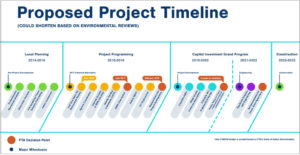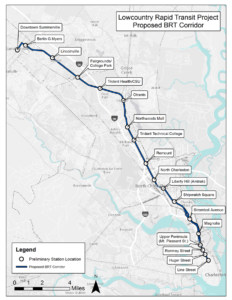By Kyra Morris, contributing editor | Community anticipation has been growing in recent months for the Lowcountry Rapid Transit (LCRT) project, which would serve as the spine of a premium mass transportation system in the Charleston region.
As proposed, LCRT would connect Summerville, North Charleston and downtown Charleston, running largely in dedicated, separated lanes, while providing relief from traffic congestion.
The LCRT is often referred to as “light rail on wheels.” LCRT would perform more like a train service than a bus route with many of the same conveniences, such as level boarding and wide doors on both sides of vehicles, modern transit stations, pre-payment, free Wi-Fi and more.
The LCRT project is proposed to operate primarily down the center median of Rivers Avenue, with limited stops at key locations. The large vehicles, holding up to 85 passengers, would have automated priority at intersections, allowing for LCRT to stay on schedule.
In short, it would be unlike anything the Charleston region as ever seen.
More than transit
Lowcountry Rapid Transit is a complex and forward-thinking system. The concept is backed by thoroughly studied methodologies relating to community building and development. Data shows that citizens who live in thoughtfully created, relatively dense, mixed-use, walkable environments enjoy longer and healthier lives.
But how do we get from a transit system concept to creating sustainable, prosperous healthy communities? I spoke with Steve Dudash, chairman of the Berkeley-Charleston-Dorchester Council of Governments’ (BCDCOG) Mass Transit Advocacy Committee (MTAC). Dudash has been a proponent of premium mass transit for more than a decade, having researched similar systems – and their correlated community development process – throughout the world.
“Bus rapid transit, and the transit-oriented development that it inspires, is based on real science, and it can help us re-think the sprawl verses density debate in a much more productive way,” Dudash said.
In 2012, the BCDCOG commissioned a large-scale study, the I-26alt Alternatives Analysis, with the intention of identifying a fixed-guideway transit solution for congestion along Interstate 26. The I-26alt study stemmed from an earlier commuter rail feasibility study completed in 2007 and updated in 2011. While multiple options were examined – including light rail and commuter rail – bus rapid transit was selected as the preferred alternative. Many factors played a role, including community input, flexibility and price. A similar light rail option, for instance, was projected to cost around seven times as much as LCRT.
Last year, BCDCOG formed the MTAC to advocate in the business community for regional mass transit.
“We need to put the thinking, process and infrastructure in place that will allow us to create not just a short term fix, but a multi-generational solution,” Dudash said. “And we’ll need the whole tri-county ‘village’ to get involved to help raise this child.”
Purpose and opportunity
LCRT’s first goal would be to reduce traffic congestion along I-26 and provide safe, reliable, and efficient transportation to places of employment, hospitals and retail hubs.
“Imagine getting on a sleek, modern, low-emission vehicle, plugging into the internet and relaxing on the way to your destination,” Dudash said, “versus navigating and fighting inevitable traffic.”
Dudash, added that opportunity for everyone in the community is a key theme for LCRT.
“For residents along the corridor, it’s unprecedented connectivity to jobs, healthcare, food and education,” he said. “For motorists, it means fewer cars on the road. For commuters it means being able to avoid gridlock, and for the region it’s an opportunity for unrivaled connectivity.”
Costs and funding
In 2016, Charleston County voters passed a half-cent sales tax referendum that, in part, provided essential funding for LCRT to apply for matching federal grants. Estimated construction costs are currently $360 million, with annual operating costs of about $5.9 million. BCDCOG is serving as the project sponsor and has an ongoing commitment to participate in obtaining federal grants from agencies such as the Federal Transit Administration, which is lead oversight agency for LCRT.
Proposed route and stations
Station locations are proposed, and BCDCOG will be going through a community-driven study process to finalize them. Eighteen stations are currently proposed, from Summerville to Line Street in Charleston, and the station areas have been strategically identified to serve activity centers such as Trident Health, Charleston Southern University, the North Charleston Transit Center, Charleston’s upper peninsula and more. A final connection to the medical district downtown will also be vital.
Travelers using the system would pre-purchase tickets, eliminating time-consuming exchanges when boarding. The stations will be designed as secure, permanent structures with weather protection.
Timeline and next steps
The LCRT project engineering consultant has been hired and advanced planning and engineering is underway. The National Environmental Protection Act (NEPA), a federally mandated 2-year environmental review, will begin in 2019, with public involvement opportunities beginning in January. The successful completion of NEPA is a requirement to access federal funds. Construction would begin in 2023 with the inaugural ride projected for 2025.
Numerous premium transit corridors have already been identified by BCDCOG in its recently completed Regional Transit Framework Plan. These arteries will serve as the “skeleton” to LCRT’s spine.
“As these plans advance, what we’ll see are jobs, green spaces, wise land use and fewer single-passenger automobile trips,” Dudash said. “It will take our village to raise this transit child, and the entire community is going to be better off for it.”
Kyra H. Morris, a Certified Financial Planner, is CEO of Morris Financial Concepts, Inc., in Mount Pleasant. A national leader in the financial planning profession, she has been named several times by leading magazines as one of the country’s top financial planners.
- Have a comment? Send to: editor@charlestoncurrents.com








 We Can Do Better, South Carolina!
We Can Do Better, South Carolina!

























2 Comments